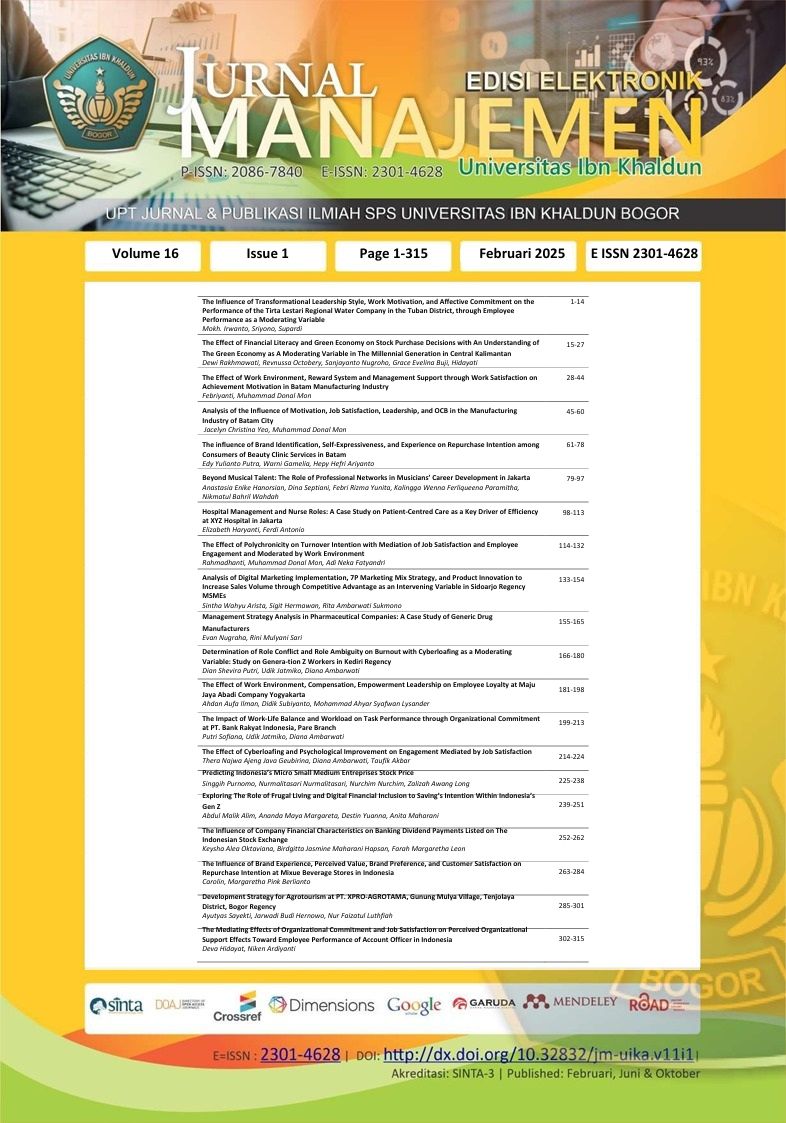The Influence of Company Financial Characteristics on Banking Dividend Payments Listed on The Indonesian Stock Exchange
DOI:
https://doi.org/10.32832/jm-uika.v16i1.18395Keywords:
Dividend Payout, Financial Distress, Firm Size, Leverage, Liquidity, ProfitabilityAbstract
This study aims to examine the impact of variables affecting dividend payouts in banking companies listed on the Indonesia Stock Exchange. The addition of financial distress as an independent variable represents a novel aspect of this research. A purposive sampling method was used to select 23 banking companies over five years (2019–2023), yielding 115 data points analyzed through panel data regression. The results show that leverage, liquidity, and firm size have no effect on dividend payout, while profitability and financial distress have a significant influence. Financial managers should evaluate the company's financial condition and con-sider factors such as leverage, liquidity, profitability, firm size, and financial distress when making dividend payout decisions. Likewise, investors should consider financial performance indicators, particularly in companies with larger, stable assets, which offer long-term returns and higher profitability. This enables investors to assess potential and make informed investment decisions.
References
Ahmed, F., Rafay, A., & Ahmed, A. (2018). Dividend Payout Policy of Conventional Banking and Islamic Banking in Pakistan. Al-Iqtishad: Jurnal Ilmu Ekonomi Syariah, 10(1). https://doi.org/10.15408/aiq.v10i1.6103
Chen, Y.-C., Hung, M., & Wang, Y. (2018). The effect of mandatory CSR disclosure on firm profitability and social externalities: Evidence from China. Journal of Accounting and Economics, 65(1), 169–190. https://doi.org/https://doi.org/10.1016/j.jacceco.2017.11.009
Farah Chintya, B., & Andrianantenaina, H. (2020). Profitability, Liquidity, Leverage and Firm Size on Dividend Policy. Perspektif Akuntansi, 3(2), 155–166. https://doi.org/10.24246/persi.v3i2.p155-166
Fitriati, I. R., Chabachib, M., & Muharam, H. (2018). Analisis Pengaruh Return on Equity, Firm Size, Current Ratio Dan Institutional Ownership Terhadap Dividend Payout Ratio Dengan Debt To Equity Ratio Sebagai Variabel Intervening. In Jurnal Riset Ekonomi dan Bisnis (Vol. 11, Issue 3, p. 174). https://doi.org/10.26623/jreb.v11i3.1142
Hariyanti, N., & Pangestuti, I. R. (2021). Pengaruh Profitabilitas, Leverage, Likuiditas, Collateralizable Assets, dan Growth in Net Assets terhadap Kebijakan Dividen dengan Firm Size, Firm Age, dan Board Size sebagai Variabel Kontrol. Diponegoro Journal of Management, 10(3), 1–15.
Hidayat, D., Hermuningsih, S., & Maulida, A. (2022). Pengaruh Profitabilitas, Likuiditas, Leverage, dan Ukuran Perusahaan terhadap Kebijakan Dividen. Al-Kharaj : Jurnal Ekonomi, Keuangan & Bisnis Syariah, 4(3), 895–913. https://doi.org/10.47467/alkharaj.v4i3.749
Indrati, M., & Amelia, K. (2022). The Effect of Profitability, Liquidity, Leverage and Company Size on the Company’s Dividend Policy. In Budapest International Research and Critics Institute-Journal (BIRCI-Journal) (Vol. 5, Issue 3). Budapest International Research and Critics Institute-Journal (BIRCI-Journal. https://doi.org/10.33258/birci.v5i3.6191
Kemunto Mogire, R. (2024). Firm financial characteristics and dividend payout of listed insurance companies in Nairobi Securities Exchange. International Academic Journal of Economics and Finance, 4(1), 195–217. https://iajournals.org/articles/iajef_v4_i1_195_217.pdf
Lai, S., Wang, Q., Du, J., & Pi, S. (2021). Has the Propensity to Pay Dividends Declined? Evidence from the US Banking Sector. Journal of Risk and Financial Management, 14(3), 103. https://doi.org/10.3390/jrfm14030103
Lihu, M. Y., & Tuli, H. (2023). Pengaruh Ukuran Perusahaan, Profitabilitas dan Leverage Terhadap Kebijakan Dividen Perusahaan Manufaktur di BEI. Jambura Accounting Review, 4(2), 250–260. https://doi.org/10.37905/jar.v4i2.92
Mai, M. U., Djuwarsa, T., & Setiawan, S. (2023). Board characteristics and dividend payout decisions: evidence from Indonesian conventional and Islamic bank. Managerial Finance, 49(11), 1762–1782. https://doi.org/10.1108/MF-11-2022-0541
Musa, H., Natorin, V., Musova, Z., & Durana, P. (2020). Comparison of the efficiency measurement of the conventional and Islamic banks. Oeconomia Copernicana, 11(1), 29–58. https://doi.org/10.24136/oc.2020.002
Nguyen, P. T. (2022). The Impact of Banking Sector Development on Economic Growth: The Case of Vietnam’s Transitional Economy. Journal of Risk and Financial Management, 15(8). https://doi.org/10.3390/jrfm15080358
Rawal, A., & Gopalkrishnan, S. (2024). Impact of financial distress on the dividend policy of banks in India: evidence using panel data. Future Business Journal, 10(1). https://doi.org/10.1186/s43093-024-00310-y
Sunarwijaya, I. K., Jayanti, K. W. D., & Adiyadnya, M. S. P. (2021). Pengaruh likuiditas, profitabilitas, leverage, pertumbuhan, ukuran perusahaan terhadap kebijakan dividen perusahaan perbankan di Indonesia. Karya Riset Mahasiswa Akuntansi, 1(1), 309–317.
Syarifudin, A. (2021). Pengaruh Leverage Terhadap Profitabilitas Dan Return Saham Dengan Intervening Asset Growth Pada Perusahaan Go Public Di Bei Periode 2011-2019. JABE (Journal of Applied Business and Economic), 8(1), 56. https://doi.org/10.30998/jabe.v8i1.10581
Downloads
Published
How to Cite
Issue
Section
License
Copyright (c) 2024 Jurnal Manajemen

This work is licensed under a Creative Commons Attribution-NonCommercial 4.0 International License.
Authors who publish with this journal agree to the following terms:
- Authors retain copyright and grant the journal right of first publication with the work simultaneously licensed under a Creative Commons Attribution-NonCommercial-ShareAlike 4.0 International License that allows others to share the work with an acknowledgement of the work's authorship and initial publication in this journal.
- Authors can enter into separate, additional contractual arrangements for the non-exclusive distribution of the journal's published version of the work (e.g., post it to an institutional repository or publish it in a book), with an acknowledgement of its initial publication in this journal.
- Authors are permitted and encouraged to post their work online (e.g., in institutional repositories or on their website) prior to and during the submission process, as it can lead to productive exchanges, as well as earlier and greater citation of published work (See The Effect of Open Access).











